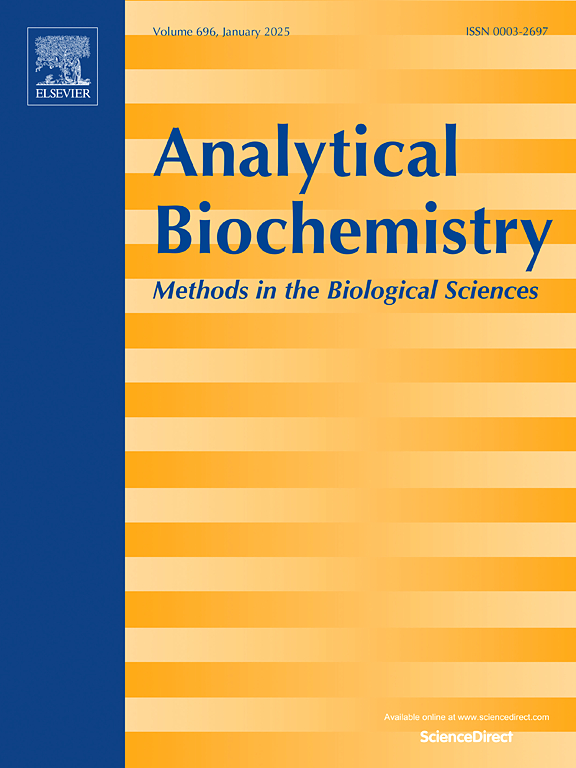Evaluation of a multiplexed assay for six urinary proteins based on liquid microarray analysis technology
IF 2.6
4区 生物学
Q2 BIOCHEMICAL RESEARCH METHODS
引用次数: 0
Abstract
Proteinuria serves as a critical indicator in the progression of chronic kidney disease. The quantification of urinary protein is instrumental in diagnosing kidney disease and monitoring therapeutic efficacy. Nephelometry and turbidimetric immunoassay are predominantly employed for the quantitative detection of various urinary proteins. We developed a quantitative detection method for six proteins in urine utilizing the flow fluorescence luminescence method on the Luminex®200™ detection platform. This study aims to evaluate the clinical performance and accuracy of the method. The sensitivity, precision, recovery, linearity, and interference metrics for the method meet the needs of clinical applications. The correlation coefficient (r) between the results of the method and nephelometry immunoassay on SIEMENS BNII platform ranged from 0.9375 to 0.9847, indicating a strong linear relationship. The results of the Bland-Altman analysis indicated that the systematic bias between the two methods was minimal. Additionally, Passing-Bablok regression analysis, both including and excluding outliers, was conducted on the clinical trial data. The findings demonstrated consistency between the two methods, with the expected confidence interval of bias remaining within the allowable error limits, indicating no significant discrepancy. This urine six protein quantification method demonstrates satisfactory performance, meeting the standards necessary for medical diagnosis and clinical application.

基于液体微阵列分析技术的6种尿蛋白多路检测方法的评价。
蛋白尿是慢性肾脏病进展的一个重要指标。尿蛋白定量有助于诊断肾脏疾病和监测疗效。定量检测各种尿蛋白主要采用肾镜法和比浊免疫法。我们在 Luminex®200™ 检测平台上利用流动荧光发光法开发了一种尿液中六种蛋白质的定量检测方法。本研究旨在评估该方法的临床性能和准确性。该方法的灵敏度、精确度、回收率、线性度和干扰度指标均能满足临床应用的需要。该方法与西门子 BNⅡ平台上的神经虹吸免疫测定的结果之间的相关系数(r)为 0.9375 至 0.9847,表明两者之间有很强的线性关系。Bland-Altman 分析结果表明,两种方法之间的系统偏差很小。此外,还对临床试验数据进行了 Passing-Bablok 回归分析,包括异常值和排除异常值。结果表明,两种方法具有一致性,偏差的预期置信区间保持在允许误差范围内,表明没有明显差异。这种尿液六种蛋白定量方法的性能令人满意,符合医学诊断和临床应用所需的标准。
本文章由计算机程序翻译,如有差异,请以英文原文为准。
求助全文
约1分钟内获得全文
求助全文
来源期刊

Analytical biochemistry
生物-分析化学
CiteScore
5.70
自引率
0.00%
发文量
283
审稿时长
44 days
期刊介绍:
The journal''s title Analytical Biochemistry: Methods in the Biological Sciences declares its broad scope: methods for the basic biological sciences that include biochemistry, molecular genetics, cell biology, proteomics, immunology, bioinformatics and wherever the frontiers of research take the field.
The emphasis is on methods from the strictly analytical to the more preparative that would include novel approaches to protein purification as well as improvements in cell and organ culture. The actual techniques are equally inclusive ranging from aptamers to zymology.
The journal has been particularly active in:
-Analytical techniques for biological molecules-
Aptamer selection and utilization-
Biosensors-
Chromatography-
Cloning, sequencing and mutagenesis-
Electrochemical methods-
Electrophoresis-
Enzyme characterization methods-
Immunological approaches-
Mass spectrometry of proteins and nucleic acids-
Metabolomics-
Nano level techniques-
Optical spectroscopy in all its forms.
The journal is reluctant to include most drug and strictly clinical studies as there are more suitable publication platforms for these types of papers.
 求助内容:
求助内容: 应助结果提醒方式:
应助结果提醒方式:


